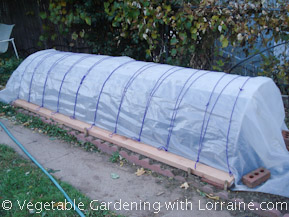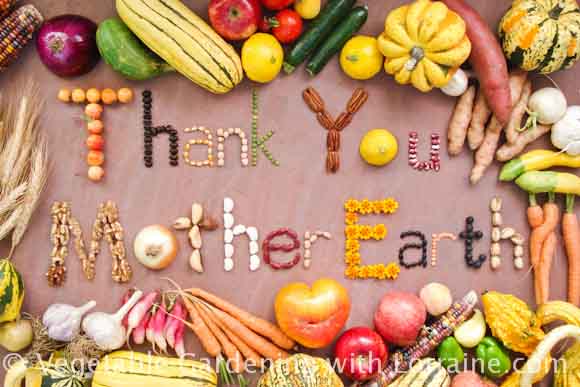- Home
- Fall Gardening
Fall Vegetable Gardening
 My Hoop Tent for Fall Gardening
My Hoop Tent for Fall GardeningFall vegetable gardening is something many gardeners overlook, but it can be very productive and rewarding to keep growing vegetables up to and even past your fall frost date. “Spring” greens like spinach and arugula, as well as the slower-growing cool season crops like broccoli and cauliflower are all great choices for growing into the fall, and are a welcome change of pace after the summer surge of tomatoes, peppers and cucumbers.
But fall gardening should really be called “mid-summer gardening”, because that’s the time when the action happens. You have to remember to start your fall seedlings indoors (or in another cool place) before you’ve even harvested your first tomatoes. When everything else is in full swing in the middle of summer, remembering to start seedlings for fall gardening is probably not on your radar.
Great Crops for Fall Gardening
|
Brassica
|
Root
|
Leafy
|
Onion
|
Cabbage Family Crops (Brassicas)
Crops that thrive in the cooler weather of fall need cooler temperatures to germinate… but it’s July, so you’re in a bind. Start your cabbage family seedlings for fall gardening in a bright spot inside, a cooler area outdoors (say, dappled shade or on the north side of your house), or under fluorescent lights in the basement. It may not be intuitive, but most seeds actually do need bright light to germinate, as well as to grow.
Start-times for cabbage family crops are about 3 or 3½ months before your first frost date. Use your gardening calendar to count backwards. Don’t leave it too late, or the plants won’t have time to give you a harvestable crop before it freezes hard. If you have frost-free winters you can start them later in the season, but make sure they still have time to grow before cold weather stunts them.
Where I live in the Rocky Mountains, fall gardening is challenging because it gets so hot here in the summer, and then so cold in the winter. Finding the exact right window for planting out the fall crops is a bit of a dance.
I start my seedlings for fall gardening in flats under the grape arbor, where they get dappled shade and where it stays a little cooler. When I plant them out in the garden about 3 or 4 weeks later, I cover them with Reemay (floating row cover) which protects them from the worst of the heat. Reemay is also great for keeping flea beetles and other plant pests away from the cabbage-family crops they seem to love so much.
Make sure the young seedlings don’t dry out – both before and after transplant. Big, established crops with deep root systems have a hard enough time in the heat of summer, but little seedlings with shallow roots dry out fast and they just won’t make it if you don’t keep them well-watered.
We now use driplines to water our main garden, which have a dripper about every foot. Once plants are established and have a good root system, they can “reach” into the drip zones, but when plants are little we also water with an overhead oscillating sprinkler until their roots become established.
In spring, this overhead watering is no problem. But in mid-summer, this can lead to fungal diseases like powdery mildew. Water only the newly planted garden areas, and do so before dawn in the coolest part of the day to give the leaves time to dry off before the sun starts blasting.
Other Crops for Fall Gardening
Carrots, beets, and other root crops, as well as spinach, arugula and other greens are faster-growing and can be started 2 to 2½ months before first frost (which is in August where I live). Root crops don’t like to be transplanted, so direct seed them in the garden, but start your chard, spinach and other greens in flats where it’s cooler, as with the brassicas. Transplant them out when they are about 2 weeks old.
As with the brassicas, cover them with Reemay if it's still hot out, and keep them well-watered.
And Don't Forget the Garlic...!
If you’re planning on growing garlic, remember that is always a fall crop! For harvest next summer, plant it out within the first couple of weeks after the first fall frost. It will set roots down and get established before freezing in, and then will grow throughout the spring to be harvested early the following summer.
Hoop Tunnels
Another option for fall gardening that works really well is to use hoop tunnels (click link for YouTube video). Mine are built out of 6”x6” mesh concrete reinforcing wire, bent into curves and covered with clear plastic. I take the Reemay off my fall gardening bed as it starts to approach frost, and install the hoop tent over the top of the bed. I get an additional month of growing time on each end of the season using the hoop tunnels.
When I taught organic horticulture at Naropa University, when winter approached we strung three lines of large-bulb Christmas lights through the hoop tents, which provided a heat source that kept our garden from freezing right up until Christmas. It also looked really cool! When it got very cold, we covered each tunnel with a concrete-insulating blanket over the top at night, and tied everything down.
We put an indoor/outdoor thermometer with a remote sensor inside the hoop tunnel, and managed to keep the inside temperature above freezing until almost the end of the semester, when someone accidentally left the tents open on a 10 degrees-below-zero night and all our plants froze down (except the kale, which gets sweet after freezing, and just keeps hangin’ on!).
Some Final Thoughts
Successful fall gardening is mostly a matter of planning. There is such a small window of time between mid-summer seed-starting and getting clipped by the end-of season hard freeze, that it is really important to figure this out on paper and then make sure you do your fall-gardening tasks on schedule.
It’s so worth it, though, to be harvesting greens, carrots and parsnips as you approach Thanksgiving, from under hoop tents. Give it a try!
(Oh, and Happy Thanksgiving!)
 From My Summer and Fall Gardening Harvest
From My Summer and Fall Gardening HarvestHelp share the skills and spread the joy
of organic, nutrient-dense vegetable gardening, and please...
~ Like us on Facebook ~
Thank you... and have fun in your garden!
Affiliate Disclaimer
This website contains affiliate links to a few quality products I can genuinely recommend. I am here to serve you, not to sell you, and I do not write reviews for income or recommend anything I would not use myself. If you make a purchase using an affiliate link here, I may earn a commission but this will not affect your price. My participation in these programs allows me to earn money that helps support this site. If you have comments, questions or concerns about the affiliate or advertising programs, please Contact Me.Contact Us Page



